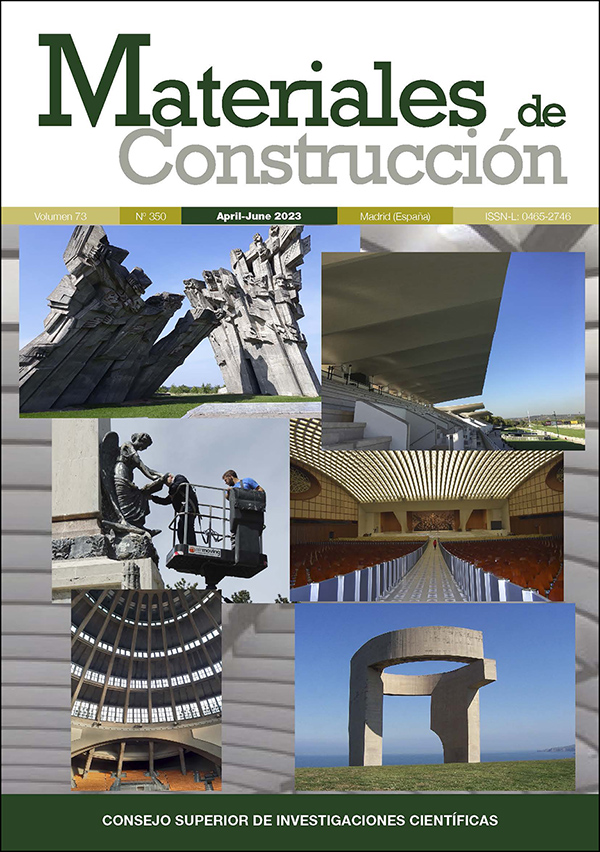Investigación experimental del mecanismo de obstrucción del hormigón permeable hecho con gradaciones variables de áridos
DOI:
https://doi.org/10.3989/mc.2023.319922Palabras clave:
Hormigón permeable, Permeabilidad, Porosidad, Resistencia a la compresión, Potencial de obstrucciónResumen
En este estudio se evaluó el mecanismo de obstrucción del hormigón permeable utilizando tres obturadores diferentes: arena (S), arcilla (C) y una combinación de arena y arcilla (S & C). El mecanismo de taponamiento se realizó a través de un aparato de permeabilidad de cabeza descendente, utilizando una carga de sedimento del obturador a razón de 50, 150 y 200 gramos en ciclos de taponamiento repetitivos. A partir de los resultados se observó que el obturador combinado (S & C) muestra resultados críticos generales de obstrucción, ya que el 80% de la obstrucción se observó de 3 a 4 ciclos. Además, se detectó que la mezcla de hormigón permeable hecha con gradación de áridos tipo R presenta una resistencia a la compresión óptima del orden de 8.6, 15.9 y 17 MPa a los 7, 28 y 56 días de curado. Finalmente, la prueba de inspección visual muestra que la obstrucción por arcilla muestra una distribución uniforme de sedimentos en toda la longitud de la muestra.
Descargas
Citas
Wang, H.; Li, H.; Liang, X.; Zhou, H.; Xie, N.; Dai, Z. (2019) Investigation on the mechanical properties and environmental impacts of pervious concrete containing fly ash based on the cement-aggregate ratio. Constr. Build. Mater. 202, 387-95. https://doi.org/10.1016/j.conbuildmat.2019.01.044
Nguyen, D.H.; Boutouil, M.; Sebaibi, N.; Baraud, F.; Leleyter, L. (2017) Durability of pervious concrete using crushed seashells. Constr. Build. Mater. 135, 137-50. https://doi.org/10.1016/j.conbuildmat.2016.12.219
Calkins, J.; Kney, A.; Suleiman, M.T.; Weidner, A. (2010) Removal of heavy metals using pervious concrete material. World Environ. Wat. Res. Cong. 37, 74-83.4.Gaedicke, C.; Marines, A.; Miankodila, F. (2014) A method for comparing cores and cast cylinders in virgin and recycled aggregate pervious concrete. Constr. Build. Mater. 52, 494-503. https://doi.org/10.1016/j.conbuildmat.2013.11.043
Ali, T.K.M.; Hilal, N.; Faraj, R.H.; Al-Hadithi, A.I. (2020) Properties of eco-friendly pervious concrete containing polystyrene aggregates reinforced with waste PET fibers. Innov. Infrastruct. Solut. 77, 1-16. https://doi.org/10.1007/s41062-020-00323-w
Nazeer, M.; Kapoor, K.; Singh, S.P. (2023) Strength and microstructural properties of pervious concrete made with different powder to aggregate ratios. Eur. J. Environ. Civ. Eng. 1-25. https://doi.org/10.1080/19648189.2023.2168763
Ramkrishnan, R.; Abilash, B.; Trivedi, M.; Varsha, P.; Varun, P.; Vishanth, S. (2018) Effect of mineral admixtures on pervious concrete. Mater. Today Proc. 5 [11], 24014-24023. https://doi.org/10.1016/j.matpr.2018.10.194
Lu, G.; Liu, P.; Wang, Y.; Fabender, S.; Wang, D.; Oeser, M. (2019) Development of a sustainable pervious pavement material using recycled ceramic aggregate and bio-based polyurethane binder. J. Clean. Prod. 220, 1052-1060. https://doi.org/10.1016/j.jclepro.2019.02.184
Yang, J.; Jiang, G. (2003) Experimental study on properties of pervious concrete pavement materials. Cem. Conc. Res. 33 [3], 381-386. https://doi.org/10.1016/S0008-8846(02)00966-3
Aman, A.M.N.; Selvarajoo, A.; Chong, S.; Teo, F.Y. (2022) Comparative life cycle assessment of pervious concrete production in Malaysia with natural and recycled aggregate. Innov. Infrastruct. Solut. 7, 211. https://doi.org/10.1007/s41062-022-00801-3
Zhang, Y.; Li, H.; Abdelhady, A.; Yang, J. (2020) Effect of different factors on sound absorption property of porous concrete. Transp. Res. Part D. 87, 102532. https://doi.org/10.1016/j.trd.2020.102532
Ibrahim, A.; Mahmoud, E.; Yamin, M.; Chowdary, V. (2013) Experimental study on Portland cement pervious concrete mechanical and hydrological properties. Constr. Build. Mater. 50, 524-529. https://doi.org/10.1016/j.conbuildmat.2013.09.022
Wang, H.; Li, H.; Liang, X.; Zhou, H.; Xie, N.; Dai, Z. (2019) Investigation on the mechanical properties and environmental impacts of pervious concrete containing fly ash based on the cement-aggregate ratio. Constr. Build. Mater. 202, 387-395. https://doi.org/10.1016/j.conbuildmat.2019.01.044
Neptune, A. (2008) Investigation of the effects of aggregate properties and gradation on pervious concrete mixtures. Thesis. 1-154. Retrieved from: https://tigerprints.clemson.edu/cgi/viewcontent.cgi?article=1460&context=all_theses.15.Kia, A.; Wong, H.S.; Cheeseman, C.R. (2019) High-strength clogging resistant permeable pavement. Int. J. Pavement Eng. 22 [3], 271-282. https://doi.org/10.1080/10298436.2019.1600693
Liu, R.; Chi, Y.; Chen, S.; Jiang, Q.; Meng, X.; Wu, K. (2020) Influence of pore structure characteristics on the mechanical and durability behavior of pervious concrete material based on image analysis. Int. J. Concr. Struct. Mater. 14, 29. https://doi.org/10.1186/s40069-020-00404-1
El-Hassan, H.; Kianmehr, P.; Zouaoui, S. (2019) Properties of pervious concrete incorporating recycled concrete aggregates and slag. Constr. Build. Mater. 212, 164-175. https://doi.org/10.1016/j.conbuildmat.2019.03.325
Wang, K.; Schaefer, V.R.; Kevern, J.T. (2015) Development of mix proportion for functional and durable pervious concrete. NRMCA Con. Tech. Forum. 1-12.19.Mulyono, T.; Anisah, M.T. (2019) Properties of pervious concrete with various types and sizes of aggregate. MATEC Web Conf. 276, 01025. https://doi.org/10.1051/matecconf/201927601025
Lim, E.; Hwee, K.; Fang, T. (2013) Effect of mix proportion on strength and permeability of pervious concrete for use in pavement. J. East. Asia Soc. Tran. Studies. 1-11.21.Yeih, W.; Fu, T.C.; Chang, J.J.; Huang, R. (2015) Properties of pervious concrete made with air-cooling electric arc furnace slag as aggregates. Constr. Build. Mater. 93, 737-745. https://doi.org/10.1016/j.conbuildmat.2015.05.104
Chopra, M.; Asce, M.; Kakuturu, S.; Asce, A.M.; Ballock, C.; Asce, A.M. (2010) Effect of rejuvenation methods on the infiltration rates of pervious concrete pavements. J. Hyd. Eng. 15 [6], 426-33. https://doi.org/10.1061/(ASCE)HE.1943-5584.0000117
Singh, D.; Singh, S.P. (2020) Influence of recycled concrete aggregates and blended cements on the mechanical properties of pervious concrete. Innov. Infrastruct. Solut. 5, 66. https://doi.org/10.1007/s41062-020-00314-x
Aliabdo, A.A.; Abd Elmoaty, A.E.M.; Fawzy, A.M. (2018) Experimental investigation on permeability indices and strength of modified pervious concrete with recycled concrete aggregate. Constr. Build. Mater. 193, 105-27. https://doi.org/10.1016/j.conbuildmat.2018.10.182
Sun, Z.; Lin, X.; Vollpracht, A. (2018) Pervious concrete made of alkali activated slag and geopolymers. Constr. Build. Mater. 189, 797-803. https://doi.org/10.1016/j.conbuildmat.2018.09.067
Aydin, S.; Yazici, H. (2010) Effect of aggregate type on mechanical properties of RPC. J. Mod. Tech. Eng. 107 [5], 441-449.27.Zhang, Z.; Zhang, Y.; Yan, C.; Liu, Y. (2017) Influence of crushing index on properties of recycled aggregates pervious concrete. Constr. Build. Mater. 135, 112-118. https://doi.org/10.1016/j.conbuildmat.2016.12.203
Sun, Z.; Lin, X.; Vollpracht, A. (2018) Pervious concrete made of alkali activated slag and geopolymers. Constr. Build. Mater. 189, 797-803. https://doi.org/10.1016/j.conbuildmat.2018.09.067
Kayhanian, M.; Anderson, D.; Harvey, J.T.; Jones, D.; Muhunthan, B. (2012) Permeability measurement and scan imaging to assess clogging of pervious concrete pavements in parking lots. J. Environ. Manage. 95 [1], 114-23. https://doi.org/10.1016/j.jenvman.2011.09.021 PMid:22115516
Deo, O.; Asce, M.; Sumanasooriya, M.; Asce, M.; Neithalath, N. (2010) Permeability reduction in pervious concretes due to clogging: experiments and modeling. J. Mat. Civil Eng. 22 [7], 741-751. https://doi.org/10.1061/(ASCE)MT.1943-5533.0000079
Bean, E.Z.; Hunt, W.F.; Bidelspach, D.A. (2007) Field survey of permeable pavement surface infiltration rates. J. Irrig. Drain. Eng. 133 [3], 249-255. https://doi.org/10.1061/(ASCE)0733-9437(2007)133:3(249)
Sandoval, G.F.B.; de Moura, A.C.; Jussiani, E.I.; Andrello, A.C.; Toralles B.M. (2020) Proposal of maintenance methodology for pervious concrete (PC) after the phenomenon of clogging. Constr. Build. Mater. 248, 118672. https://doi.org/10.1016/j.conbuildmat.2020.118672
Winston, R.J.; Al-Rubaei, A.M.; Blecken, G.T.; Viklander, M.; Hunt,W.F. (2016) Maintenance measures for preservation and recovery of permeable pavement surface infiltration rate - The effects of street sweeping, vacuum cleaning, high pressure washing and milling. J. Environ. Manage. 169, 132-44. https://doi.org/10.1016/j.jenvman.2015.12.026 PMid:26735865
Sandoval, G.F.B.; Galobardes, I.; Toralles, B.M. (2020) Assessing the phenomenon of clogging of pervious concrete (Pc): Experimental test and model proposition. J. Buil. Eng. 29, 101203. https://doi.org/10.1016/j.jobe.2020.101203
Haselbach, L.M.; Asce, M. (2010) Potential for clay clogging of pervious concrete under extreme conditions. J. Hydr. Eng. 15 [1], 67-69. https://doi.org/10.1061/(ASCE)HE.1943-5584.0000154
Kia, A.; Wong, H.S.; Cheeseman, C.R. (2017) Clogging in permeable concrete: A review. J. Environ. Manage. 193, 221-233. https://doi.org/10.1016/j.jenvman.2017.02.018 PMid:28222353
IS: 8112-1989 (2013) Specification for 43 grade ordinary portland cement. Bur. Indian Stand. 1-17.
IS: 4031 (Part 2)-1999 (2004) Methods of physical tests for hydraulic cement, Determination of fineness by specific surface by Blaine air permeability method. Bur. Indian Stand. 1-13.
IS: 4031-1988 (1988) Methods of physical tests for Hydraulic cement. Bu.r Indian Stand. 1-6.
IS: 383-1970 (1970) Specification for coarse and fine aggreagtes from natural sources for concrete. Bur. Indian Stand. 1-24.
IS: 2386- Part I (2002) Method of test for aggregate for concrete. Particle size and shape. Bur. Indian Stand1-26.
NRMCA. Guide to Specifying Pervious Concrete.
ASTM C1754/C1754-12. (2012) Standard test method for density and void content of hardened pervious concrete. ASTM Stand. 1-3.
IS: 516 (1959) Method of tests for strength of concrete. Bur. Indian Stand. 1-30.
Haselbach, L.M.; Valavala, S.; Montes, F. (2006) Permeability predictions for sand-clogged Portland cement pervious concrete pavement systems. J. Environ. Manage. 81 [1], 42-49. https://doi.org/10.1016/j.jenvman.2005.09.019 PMid:16563606
Ramadhansyah, P.J.; Y M.I.M.; Hainin, M.R.; Warid, M.N.M.; Ibrahim, W. (2014) Porous concrete pavement containing nano-silica: Pre-review. 911, 454-458. https://doi.org/10.4028/www.scientific.net/AMR.911.454
Yao, A.; Ding, H.; Zhang, X.; Hu, Z.; Hao, R.; Yang, T. (2018) Optimum design and performance of porous concrete for heavy-load traffic pavement in cold and heavy rainfall region of NE China. Adv. Mater. Sci. Eng. 2018, 7082897. https://doi.org/10.1155/2018/7082897
Ni, T.Y.; Jiang, C.H.; Tai, H.X., Zhao, G.Q. (2014) Experimental study on sound absorption property of porous concrete pavement layer. Appl. Mech. Mater. 507, 238-241. https://doi.org/10.4028/www.scientific.net/AMM.507.238
Neithalath, N.; Marolf, A.; Weiss, J.; Olek, J. (2005) Modeling the influence of pore structure on the acoustic absorption of enhanced porosity concrete. J. Adv. Concr. Technol. 3 [1], 29-40. https://doi.org/10.3151/jact.3.29
Neithalath, N.; Weiss, J.; Olek, J. (2015) Improving the acoustic absorption of enhanced porosity concrete with fiber reinforcement. Int. RILEM. Symp. Concr. Sci. Eng. 1-16.
Committee ACI. (2015) ACI 522R-10 Report on pervious concrete. 10, 1-44.
Ćosić, K.; Korat, L.; Ducman, V.; Netinger, I. (2015) Influence of aggregate type and size on properties of pervious concrete. Constr. Build. Mater. 78, 69-76. https://doi.org/10.1016/j.conbuildmat.2014.12.073
IS: 2386-Part IV. (2016) Methods of test for aggregates for concrete: Mechanical properties. Bur. Indian Stand. New Delhi. 1-37.
ASTM C131M-20. (2014) C131/C131M-14 Standard test method for resistance to degradation of small-size coarse aggregate by abrasion and impact in the Los Angeles Machine. 5-8.
ASTM C 128-01 (2001) Standard test method for density, relative density (Specific gravity), and absorption. 1-6.
Bureau of Indian Standards (BIS) (2002) IS:2386-Part V-1963: Methods of test for aggregates for concrete. Indian Stand. 1-14.
ASTM C 127-01 (2001) Standard test method for relative density (Specific gravity) and absorption of coarse. 88, 1-6.58.ASTM C29/C29M − 17a. (2017) Standard test method for bulk density (Unit weight) and Voids in aggregate. 1, 5-9.
Publicado
Cómo citar
Número
Sección
Licencia
Derechos de autor 2023 Consejo Superior de Investigaciones Científicas (CSIC)

Esta obra está bajo una licencia internacional Creative Commons Atribución 4.0.
© CSIC. Los originales publicados en las ediciones impresa y electrónica de esta Revista son propiedad del Consejo Superior de Investigaciones Científicas, siendo necesario citar la procedencia en cualquier reproducción parcial o total.
Salvo indicación contraria, todos los contenidos de la edición electrónica se distribuyen bajo una licencia de uso y distribución “Creative Commons Reconocimiento 4.0 Internacional ” (CC BY 4.0). Consulte la versión informativa y el texto legal de la licencia. Esta circunstancia ha de hacerse constar expresamente de esta forma cuando sea necesario.
No se autoriza el depósito en repositorios, páginas web personales o similares de cualquier otra versión distinta a la publicada por el editor.
















